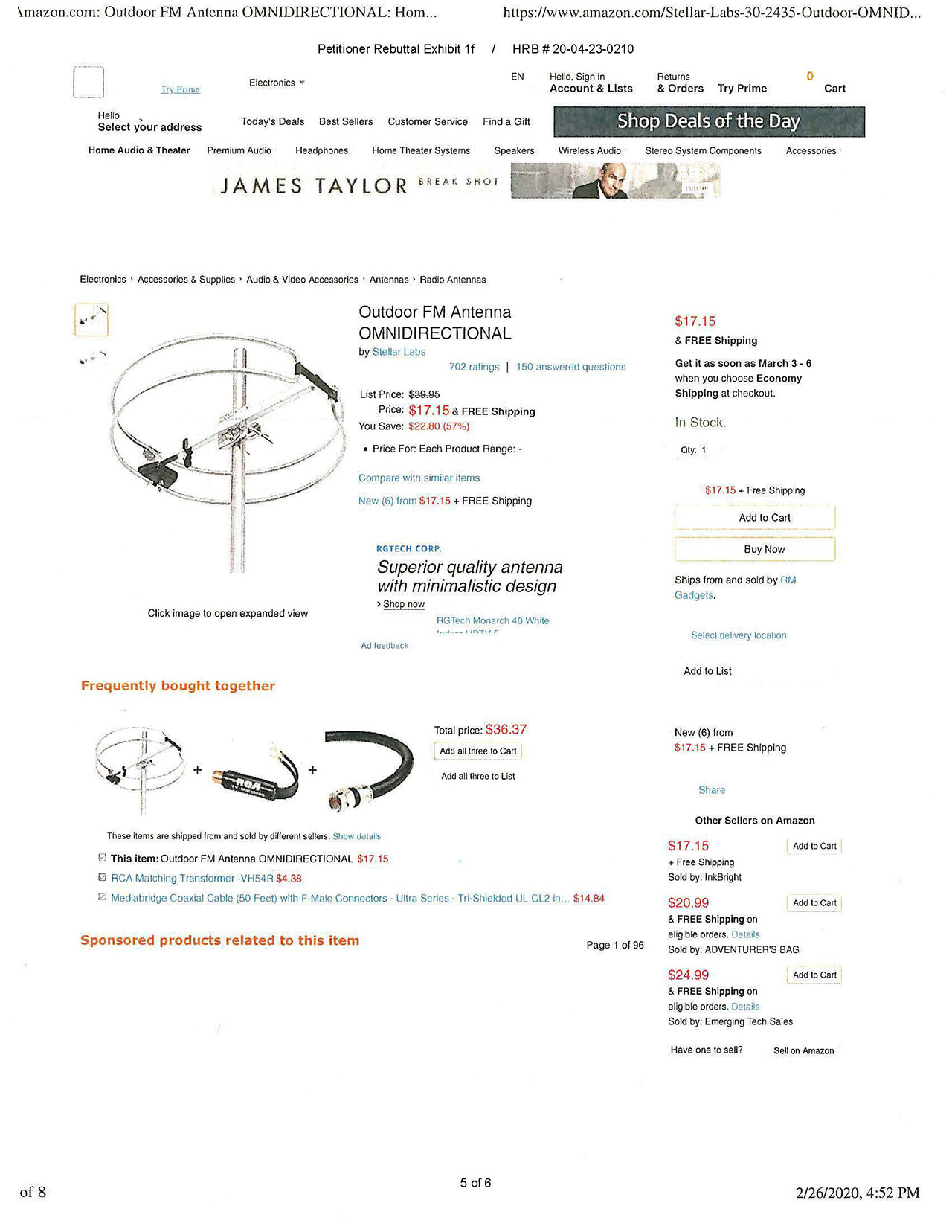EMHA vs FCC: EL MIRADOR HOMEOWNERS ASSOCIATION VIOLATES FEDERAL LAW
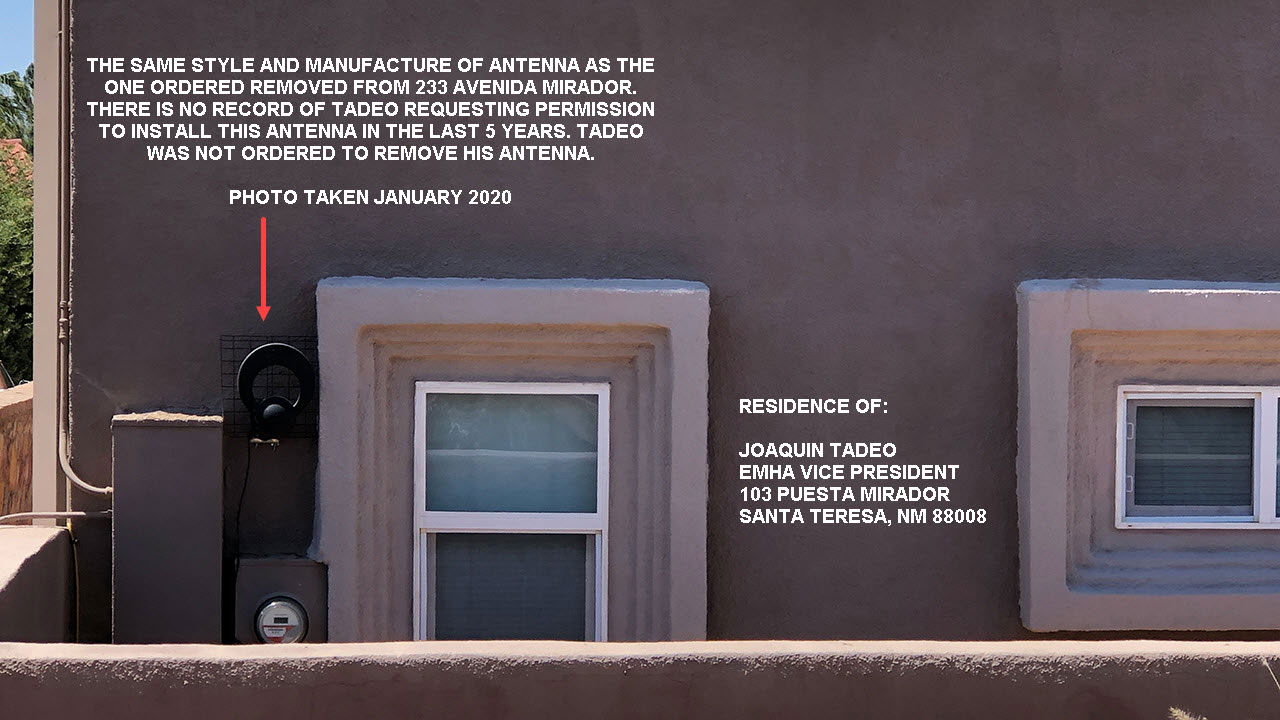
In early November 2019, Homeowner X received a certified letter from the EMHA Design Review Committee, signed by Committee Chair Timothy Hinker, and also, for some reason Henry Trost, an appointee to the Committee. The letter, among other things, demanded that the homeowner remove his broadcast television antenna, in violation of federal regulation 47 C.F.R. Section 1.4000 Over-the-Air Reception Devices (OTARD).
This harassment of the homeowner by EMHA has cost Association members more than $6,000 so far, according to Joaquin Tadeo, and those were ancillary costs. The homeowner has not yet filed suit against EMHA for discrimination, selective enforcement, harassment or for their refusal to address the hostile environment suffered by the homeowner and his family.
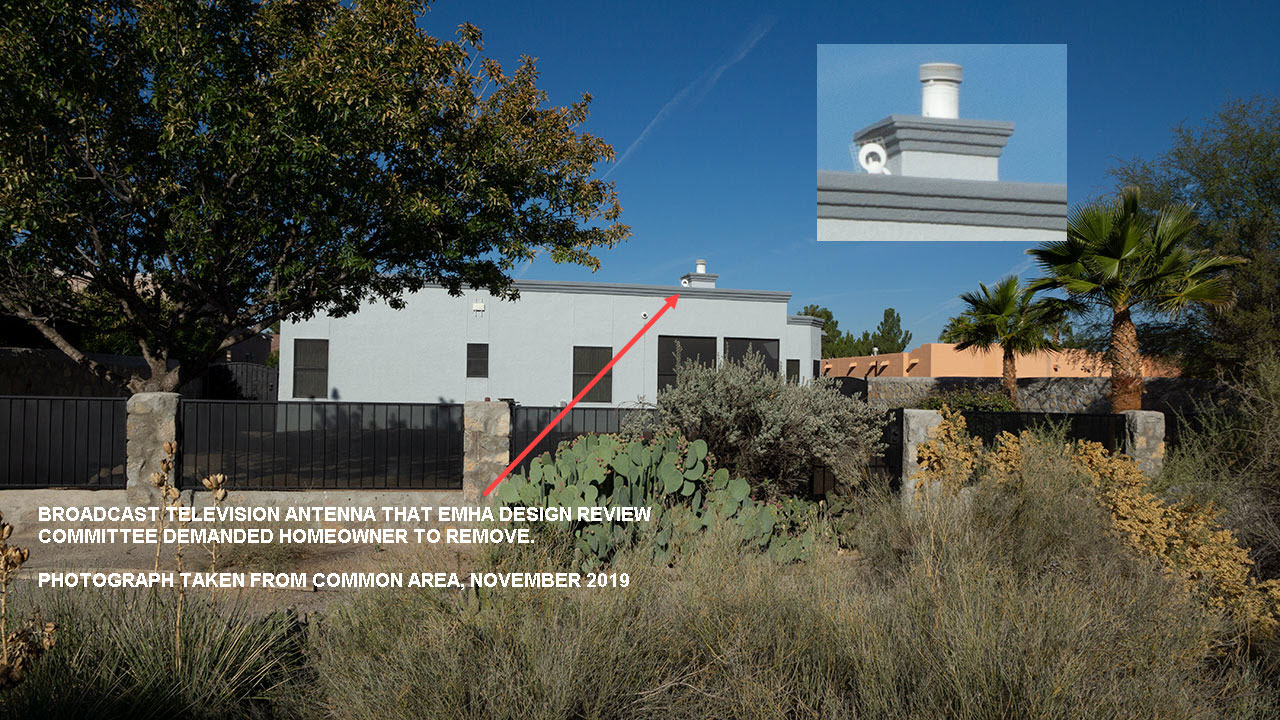
233 AVENIDA MIRADOR BROADCAST ANTENNA THAT EMHA DESIGN REVIEW COMMITTEE ORDERED HOMEOWNER TO REMOVE. PHOTOGRAPH TAKEN FROM EMHA COMMON AREA. UNLIKE ANTENNAE INSTALLED ON EMHA BOARD AND COMMITTEE MEMBER HOMES, THIS ANTENNA IS NOT VIEWABLE FROM THE STREET.
Homeowner X filed a petition for declaratory relief with the FCC against the EMHA Design Review Committee's unlawful demand. The petition identified a number of other residences within the subdivision having much larger, dish style antennae that are viewable from the street. Further, many of the antennae were installed on EMHA Boar of Director's homes. It was apparent to Homeowner X that no one else within the subdivision had been told by the EMHA Design Review Committee to remove their antenna, and that the demand was discriminatory, harassing and a blatant example of selective enforcement by the Committee.
EMHA Design Review Committee demand for removal, October 28, 2019
The homeowner asserts that the entire letter is unenforceable, containing specious demands based on false premises, entirely constituting an overt act of bad faith by the Committee through its signatories. It was sent to the EMHA Board by the Committee, all of whom refused to take appropriate action against the Committee's bad faith actions. The EMHA Board's failure to act allowed the Committee members to use their positions, and the resources of the Association, to harass and antagonize the homeowner.
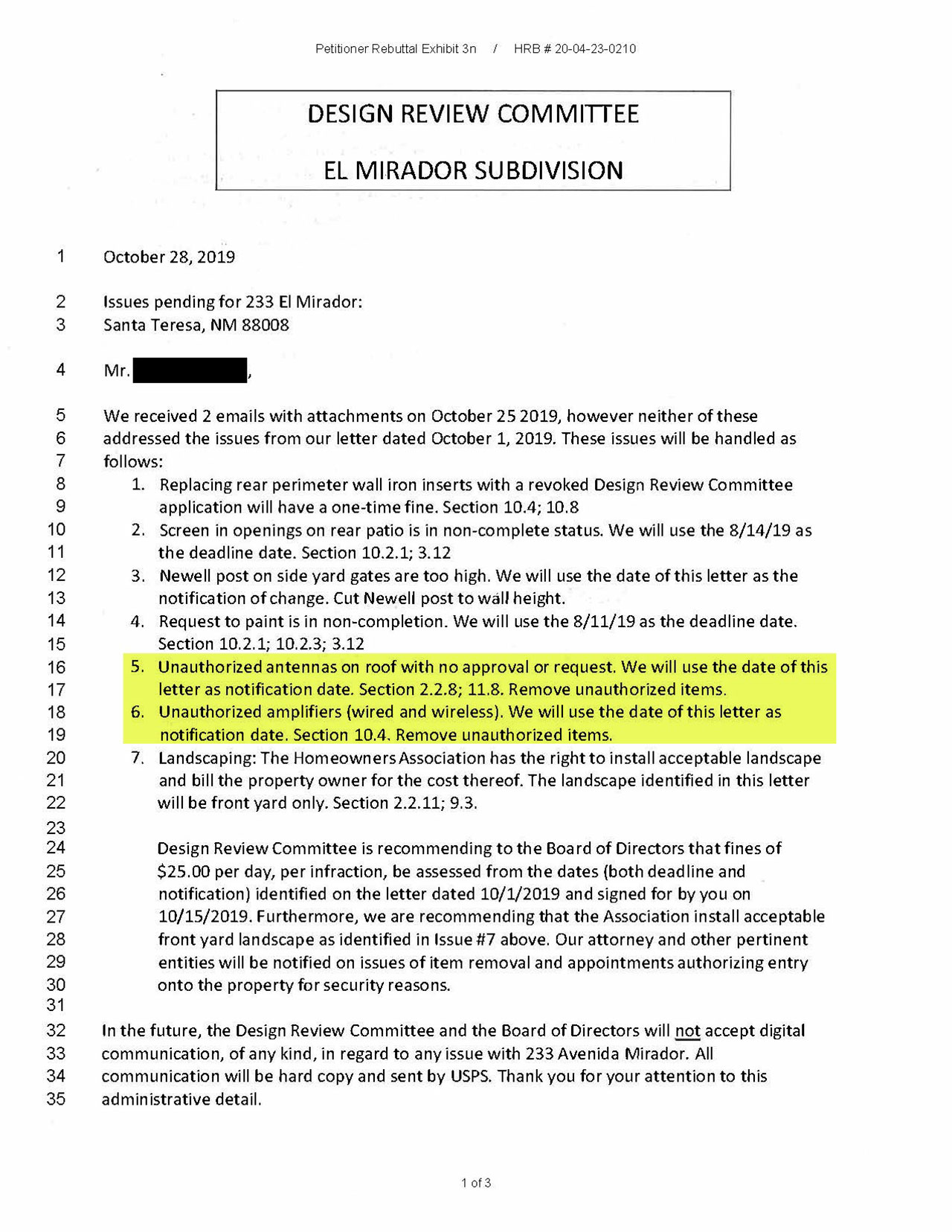
LETTER FROM EMHA DESIGN REVIEW COMMITTEE DEMANDING HOMEOWNER, AMONG OTHER THINGS, REMOVE HIS DIGITAL BROADCAST TELEVISION ANTENNA. HOMEOWNER ASSERTS THAT THE LETTER IS AN OVERT ACT OF BAD FAITH BY THE COMMITTEE.
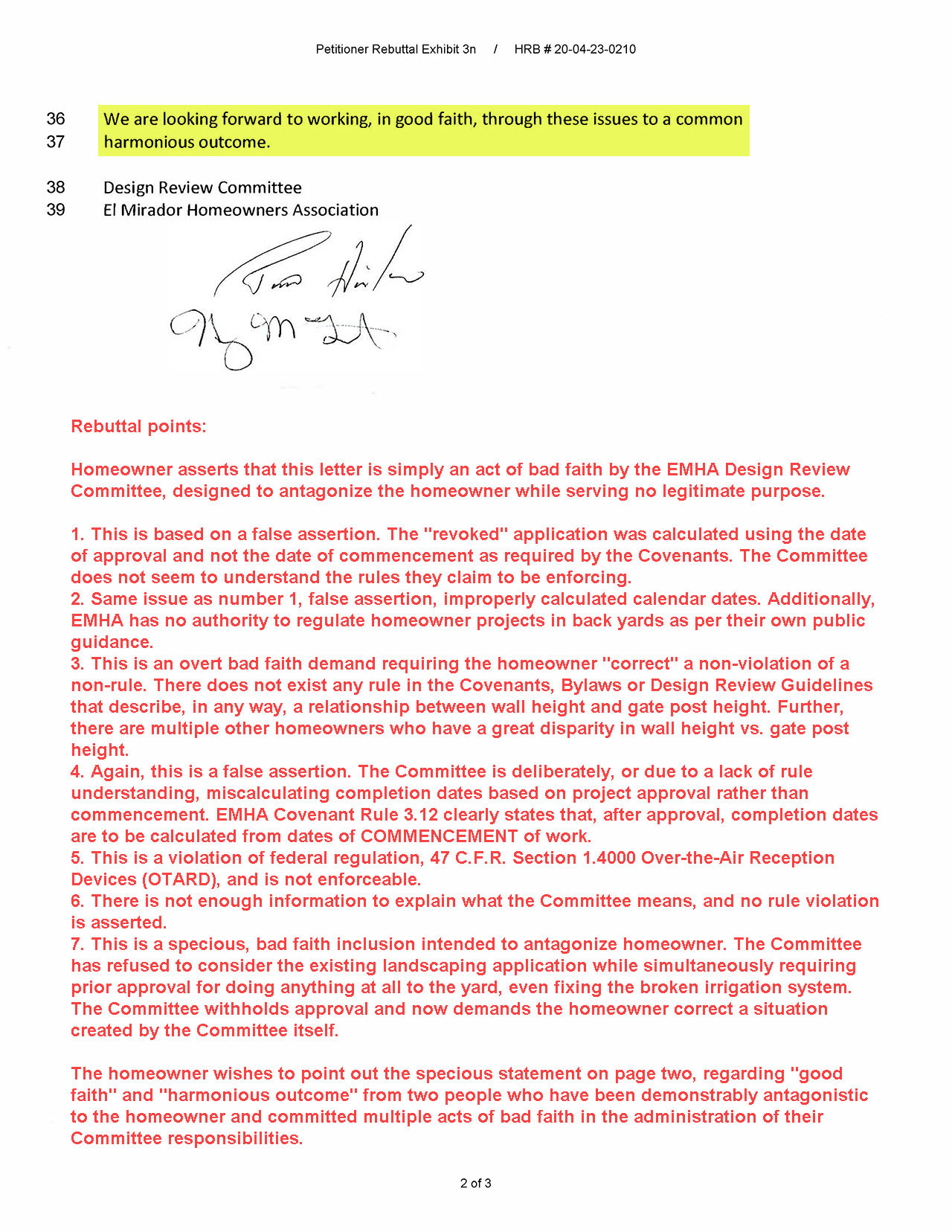
SECOND PAGE OF LETTER FROM EMHA DESIGN REVIEW COMMITTEE DEMANDING HOMEOWNER TO, AMONG OTHER THINGS, TO REMOVE HIS TELEVISION ANTENNA. HOMEOWNER ASSERTS THAT THE LETTER IS AN OVERT ACT OF BAD FAITH BY THE COMMITTEE.
In the letter, part 5 refers to Sections 2.2.8 and 11.8. Both of these sections were invalidated in 1996 by federal government regulation 47 C.F.R. Section 1.4000 Over-the-Air Reception Devices (OTARD). The association violated a (then) 23 year old FCC regulation barring homeowner associations, nationwide, from doing exactly what the EMHA Design Review Committee did in this case, unfairly targeting homeowner's with unlawful demands to remove protected antennae.
Part 6 of the letter is somewhat nonsensical, as they provide no information regarding what they mean by "unauthorized amplifiers", where they might be mounted, or why they might be a violation of Association rules.
EMHA RULES REGARDING ANTENNAE ARE UNENFORCEABLE
The rules of the Association with respect to antennae are unenforceable since 1996 due to the FCC's OTARD regulation.

EMHA COVENANTS, AS AMENDED AUGUST 2006, PAGE 26, RULE 11.8 ANTENNAS. THIS RULE, WRITTEN IN OR AROUND 1988, WAS INVALIDATED BY FCC OTARD REGULATION IN 1996, AND SUBSEQUENT REVISIONS. AS SUCH, IT IS UNENFORCEABLE BY EMHA.

EMHA DESIGN REVIEW GUIDELINES, AS AMENDED AUGUST 2019, PAGE 7, RULE 2.2.8 NO ANTENNAE.
EMHA Design Review Guideline Rule 2.2.8 No Antennae was invalidated by FCC OTARD regulation. It was "revised" and included in the new rules published by EMHA in 2019, with no record of vote by Board or Committee. To be valid a rule requires that EMHA follows procedure, which did not occur in this case. It must also comply with existing law, and fails in this regard as well. The homeowner asserts that the poorly written revision was an attempt by EMHA to allow dish style antennae while forbidding his specific digital broadcast antenna, a clear act of bad faith by both the EMHA Board and committee.
EMHA Design Review Guideline rule 2.2.8 No Antennae, as published by EMHA Secretary/Treasurer David Chavez, Jr., is a transcription error that was never corrected. In November 2004 the EMHA Design Review Guidelines were amended, and Section 2.2.8 stated, in part, that "20” satellite dishes that are not visible from the street are allowed." In a subsequent amendment, the words "are allowed" were missing. Every rule version, however, was and remains unenforceable, as OTARD invalidated such restrictions in 1996.
The EMHA Design Review Committee told the FCC, in their response, that they were recommending that DRC Guideline 2.2.8 No Antennae be deleted and that Covenant Rule 11.8 Antennas be rewritten. The EMHA Board of Directors have not acted on the suggestion of the Committee.
EMHA Design Review Committee response to homeowner's petition, December 20, 2019
The FCC notified the homeowner that the Committee had sent a response to his petition, and provided a copy. EMHA's response is largely specious reasoning, fails to deal in fact and makes vague insinuations that the homeowner is engaged in nefarious activity. The response appears to be another act of bad faith by the Committee to convince the FCC to deny homeowner's petition.
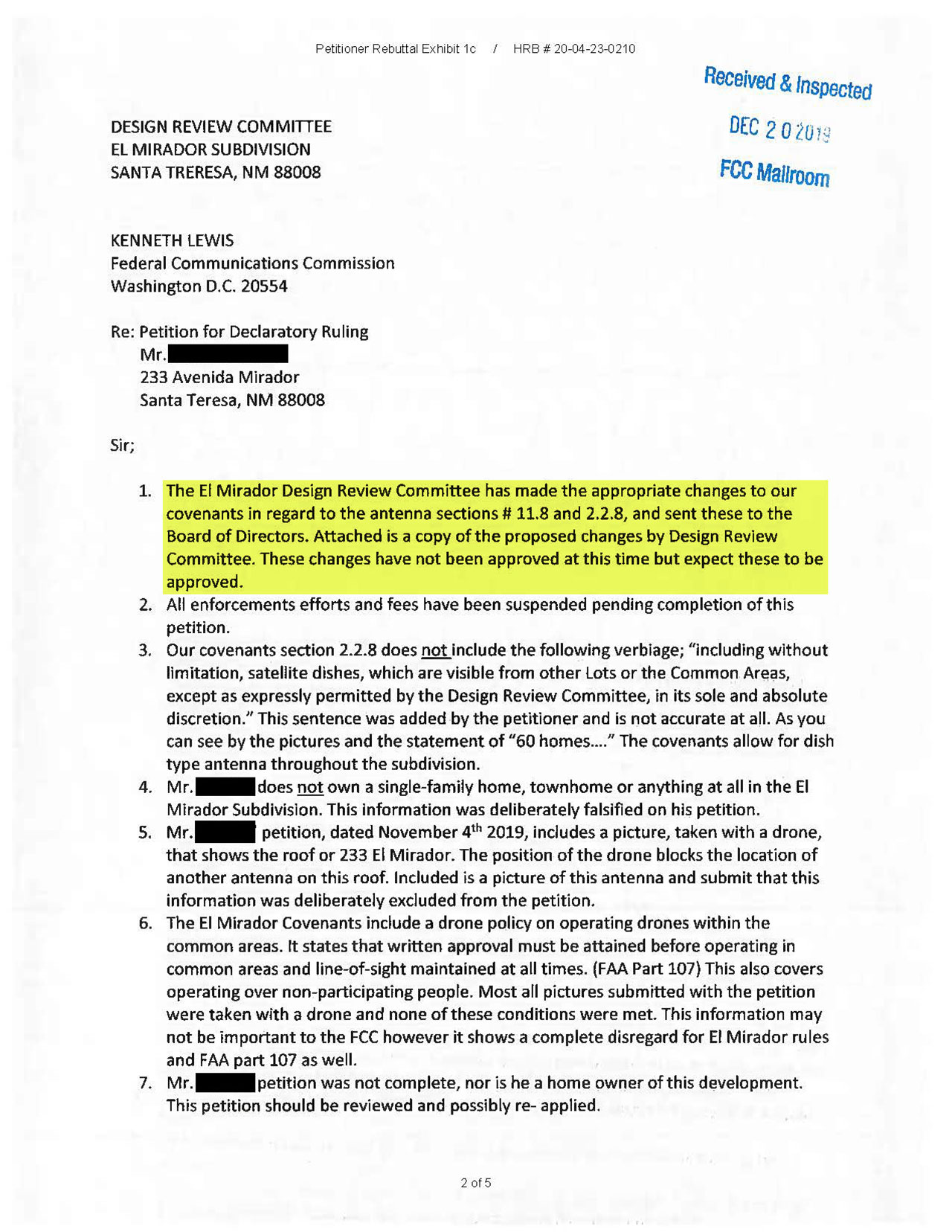
EMHA DESIGN REVIEW COMMITTEE'S RESPONSE TO FCC REGARDING HOMEOWNER PETITION FOR DECLARATORY RELIEF, PAGE 1.

EMHA DESIGN REVIEW COMMITTEE'S RESPONSE TO FCC REGARDING HOMEOWNER PETITION FOR DECLARATORY RELIEF, PAGE 2.
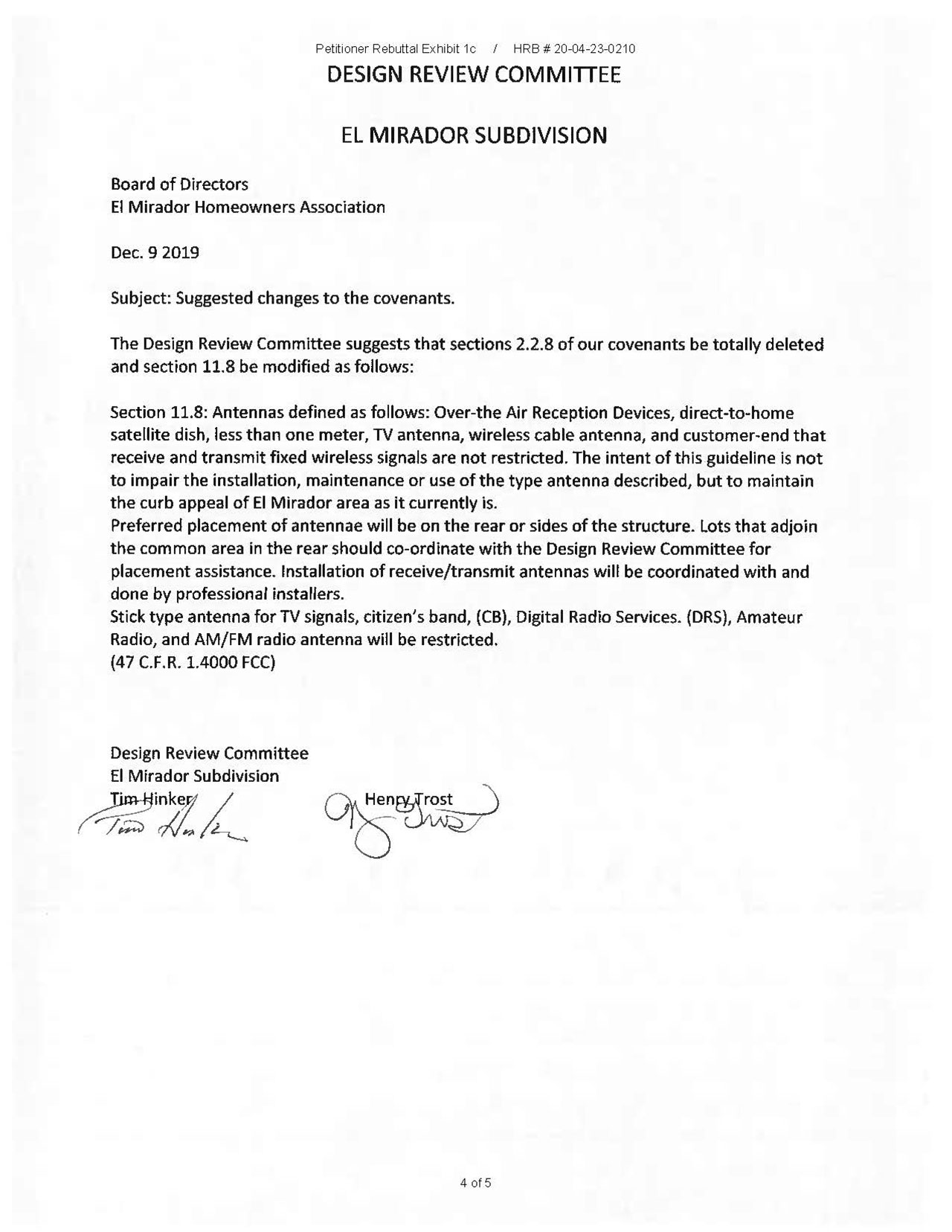
EMHA DESIGN REVIEW COMMITTEE'S RESPONSE TO FCC REGARDING HOMEOWNER PETITION FOR DECLARATORY RELIEF, PAGE 3.
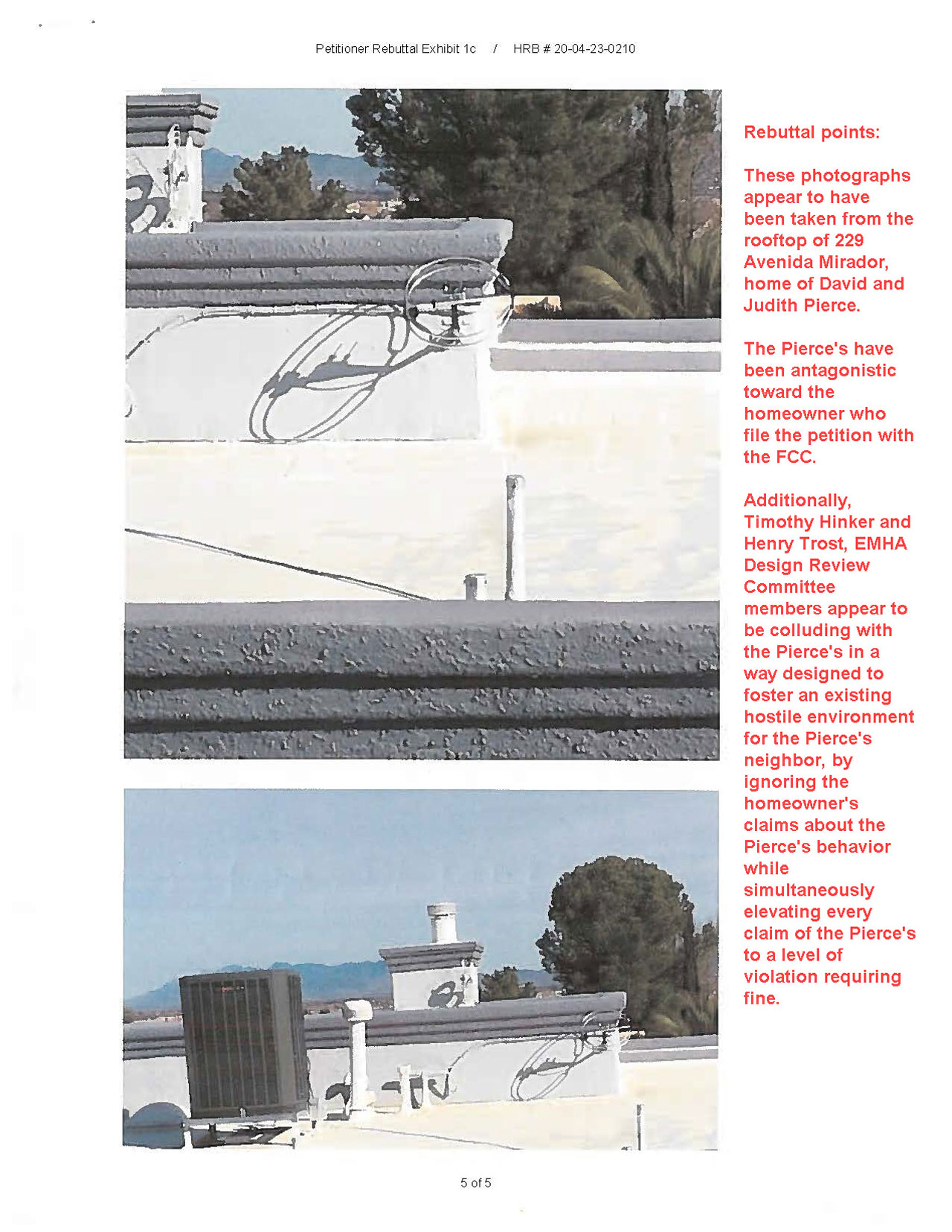
FCC RESPONDS TO EMHA
In February 2020, the FCC responded to EMHA's letter, addressing each point of their rebuttal to the homeowner's petition. The FCC attorney makes it clear that none of EMHA's points were sufficient to overcome OTARD federal protections of the homeowner's antennae. The Association could not make the homeowner remove his antennae.
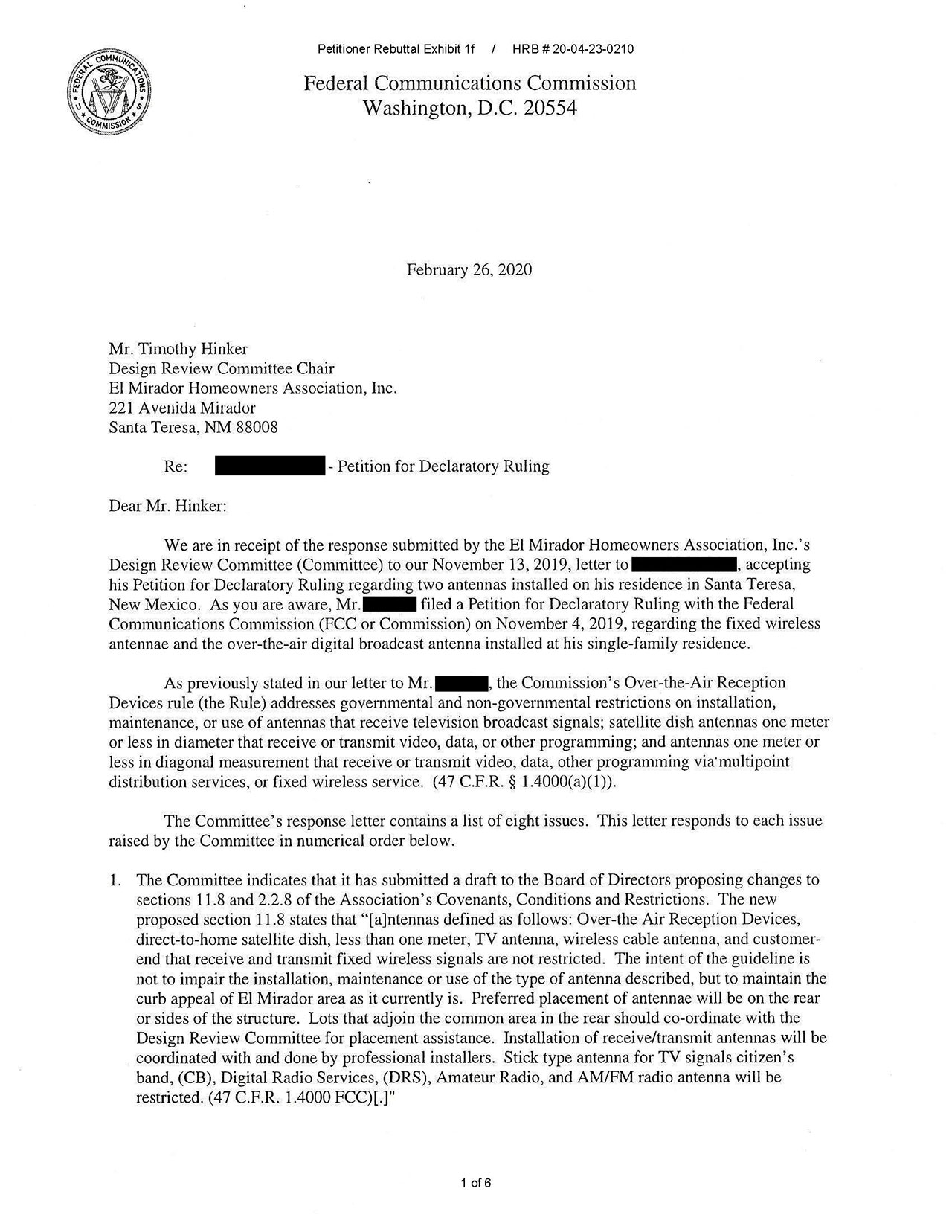
FCC RESPONSE TO EMHA, FEBRUARY 26, 2020, PAGE 1.
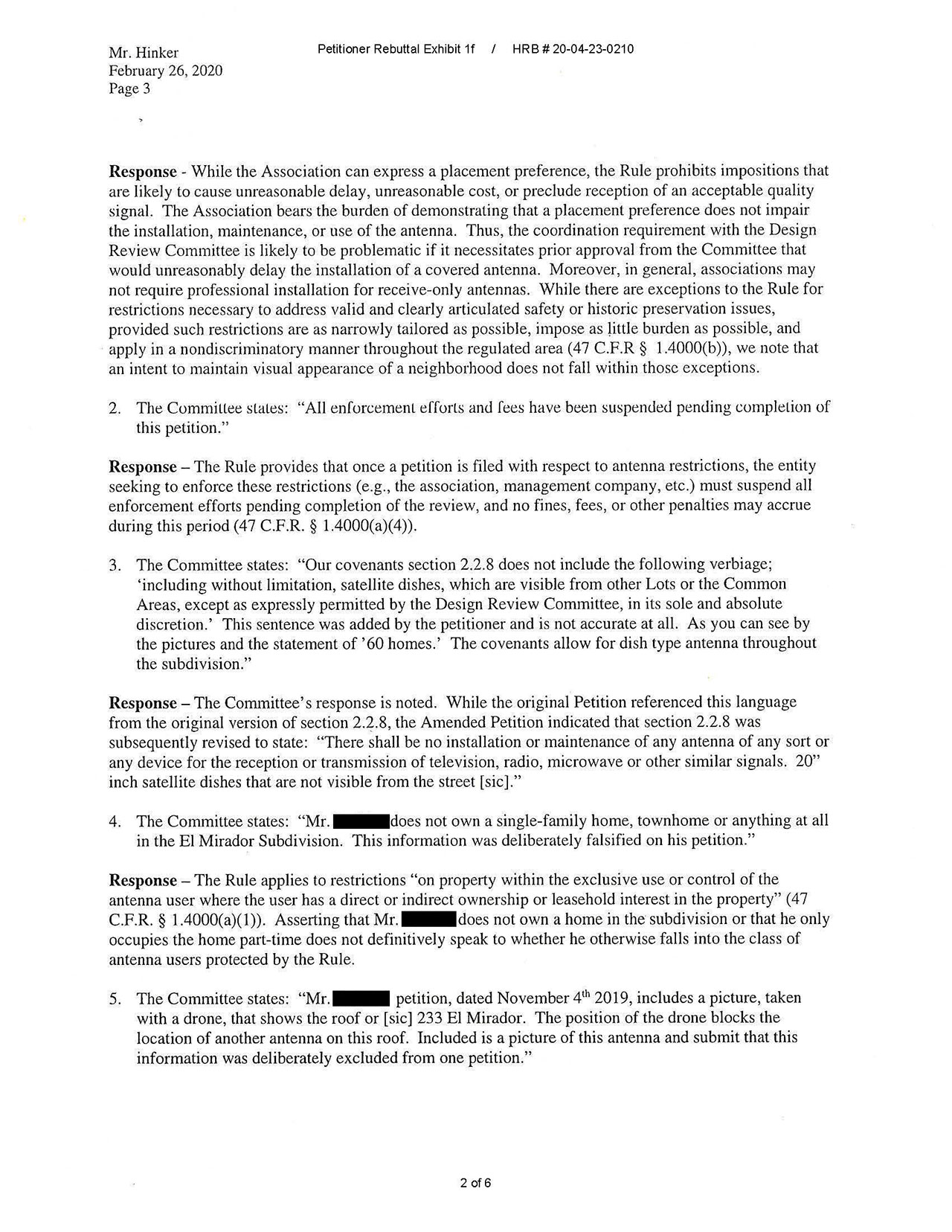
FCC RESPONSE TO EMHA, FEBRUARY 26, 2020, PAGE 2.
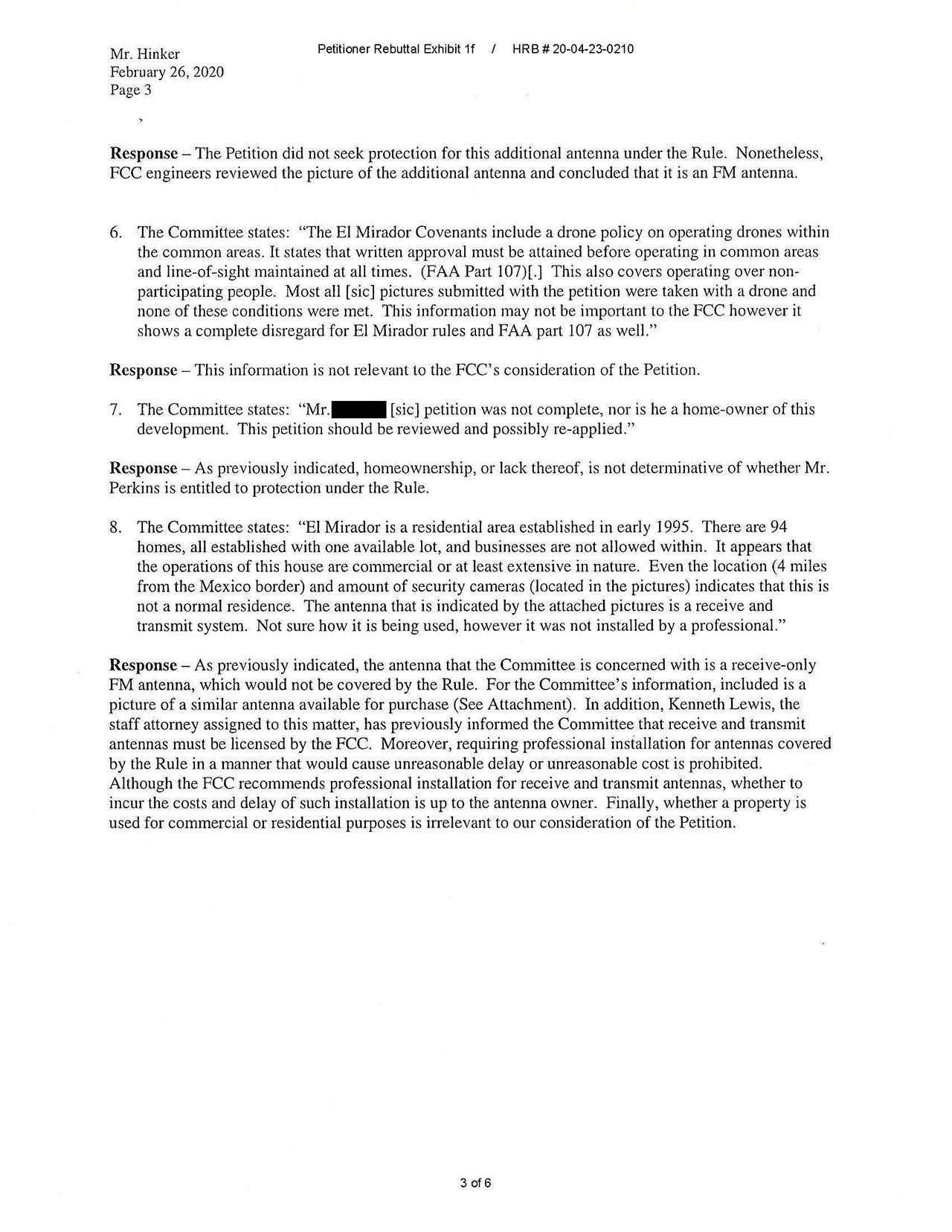
FCC RESPONSE TO EMHA, FEBRUARY 26, 2020, PAGE 3.
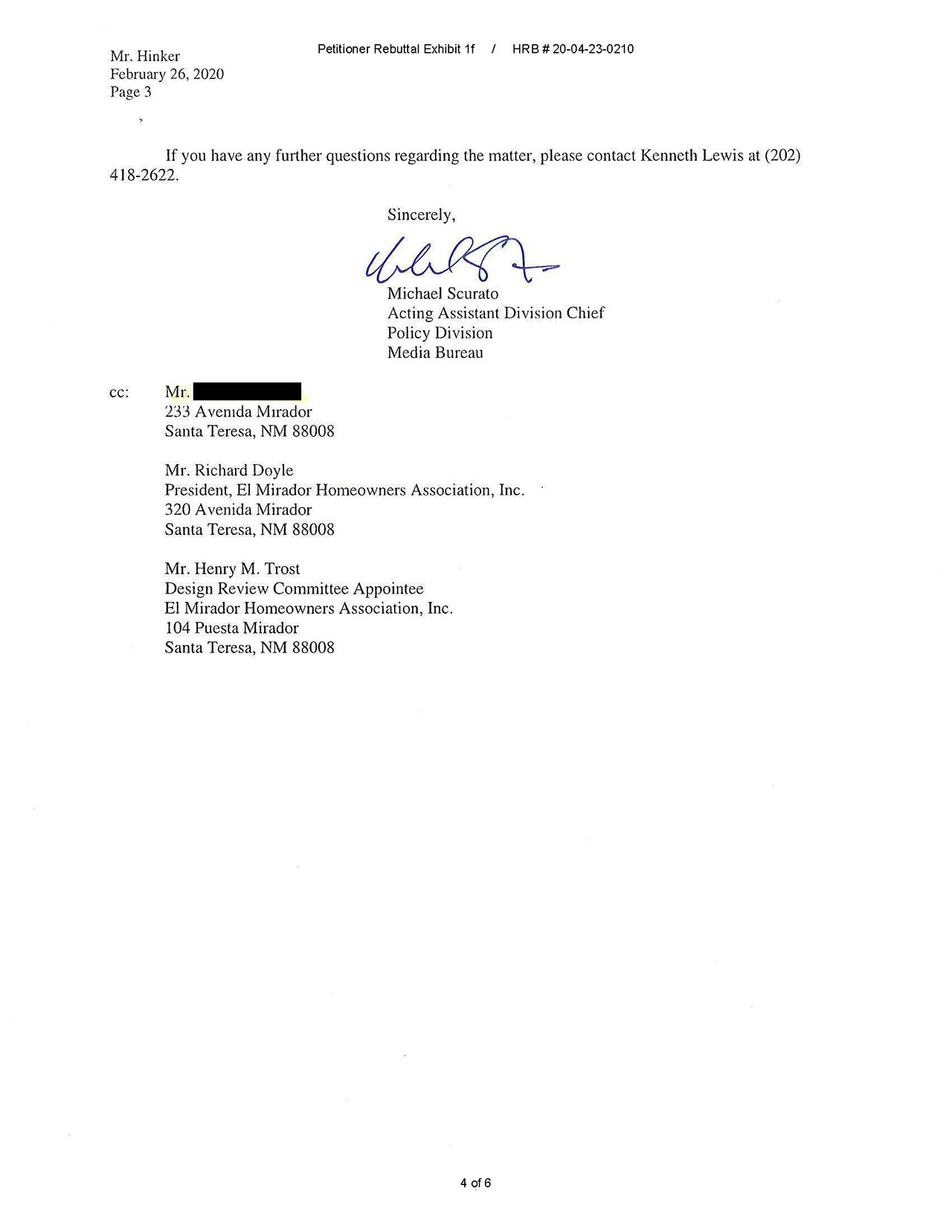
FCC RESPONSE TO EMHA, FEBRUARY 26, 2020, PAGE 4.
